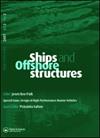中间水深对大容量浮动风力涡轮机耦合动态响应的影响机制
IF 1.8
4区 工程技术
Q2 ENGINEERING, MARINE
引用次数: 0
摘要
中国目前规划的浮式风电场大多处于中层水深。因此,研究中间水深对耦合动力系统的影响机理,可以为浮式风电场的设计提供理论依据。本文章由计算机程序翻译,如有差异,请以英文原文为准。
The impact mechanisms of intermediate water depth on the coupled dynamic responses of large-capacity floating wind turbines
The currently planned floating wind farms in China mostly have water depths in the intermediate range. Therefore, investigating the impact mechanisms of intermediate water depths on the coupled dyn...
求助全文
通过发布文献求助,成功后即可免费获取论文全文。
去求助
来源期刊

Ships and Offshore Structures
ENGINEERING, MARINE-
CiteScore
4.50
自引率
14.30%
发文量
164
审稿时长
7.5 months
期刊介绍:
Ships and Offshore Structures is an international, peer-reviewed journal which provides an authoritative forum for publication and discussion of recent advances and future trends in all aspects of technology across the maritime industry.
The Journal covers the entire range of issues and technologies related to both ships (including merchant ships, war ships, polar ships etc.) and offshore structures (floating and fixed offshore platforms, offshore infrastructures, underwater vehicles etc.) with a strong emphasis on practical design, construction and operation.
Papers of interest to Ships and Offshore Structures will thus be broad-ranging, and will include contributions concerned with principles, theoretical/numerical modelling, model/prototype testing, applications, case studies and operational records, which may take advantage of computer-aided methodologies, and information and digital technologies. Whilst existing journals deal with technologies as related to specific topics, Ships and Offshore Structures provides a systematic approach to individual technologies, to more efficiently and accurately characterize the functioning of entire systems.
The Journal is intended to bridge the gap between theoretical developments and practical applications for the benefit of academic researchers and practising engineers, as well as those working in related governmental, public policy and regulatory bodies.
 求助内容:
求助内容: 应助结果提醒方式:
应助结果提醒方式:


